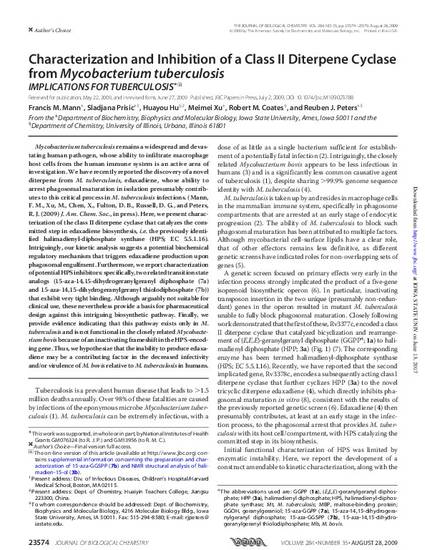
Mycobacterium tuberculosis remains a widespread and devastating human pathogen, whose ability to infiltrate macrophage host cells from the human immune system is an active area of investigation. We have recently reported the discovery of a novel diterpene from M. tuberculosis, edaxadiene, whose ability to arrest phagosomal maturation in isolation presumably contributes to this critical process in M. tuberculosis infections. (Mann, F. M., Xu, M., Chen, X., Fulton, D. B., Russell, D. G., and Peters, R. J. (2009) J. Am. Chem. Soc., in press). Here, we present characterization of the class II diterpene cyclase that catalyzes the committed step in edaxadiene biosynthesis, i.e. the previously identified halimadienyl-diphosphate synthase (HPS; EC 5.5.1.16). Intriguingly, our kinetic analysis suggests a potential biochemical regulatory mechanism that triggers edaxadiene production upon phagosomal engulfment. Furthermore, we report characterization of potential HPS inhibitors: specifically, two related transition state analogs (15-aza-14,15-dihydrogeranylgeranyl diphosphate (7a) and 15-aza-14,15-dihydrogeranylgeranyl thiolodiphosphate (7b)) that exhibit very tight binding. Although arguably not suitable for clinical use, these nevertheless provide a basis for pharmaceutical design against this intriguing biosynthetic pathway. Finally, we provide evidence indicating that this pathway exists only in M. tuberculosis and is not functional in the closely related Mycobacterium bovis because of an inactivating frameshift in the HPS-encoding gene. Thus, we hypothesize that the inability to produce edaxadiene may be a contributing factor in the decreased infectivity and/or virulence of M. bovis relative to M. tuberculosis in humans.
Available at: http://works.bepress.com/reuben_peters/36/

This research was originally published in Journal of Biological Chemistry. Mann FM, Prisic S, Hu H, Xu M, Coates RM, Peters RJ. Characterization and Inhibition of a Class II Diterpene Cyclase from Mycobacterium tuberculosis: Implicatons for tuberculosis. Journal of Biological Chemistry. 2009 Aug 28;284:23574-23579. © the American Society for Biochemistry and Molecular Biology.